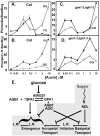Glucose attenuation of auxin-mediated bimodality in lateral root formation is partly coupled by the heterotrimeric G protein complex
- PMID: 20862254
- PMCID: PMC2941463
- DOI: 10.1371/journal.pone.0012833
Glucose attenuation of auxin-mediated bimodality in lateral root formation is partly coupled by the heterotrimeric G protein complex
Abstract
Background: Auxin and glucose are both essential elements in normal root development. The heterotrimeric G protein complex in Arabidopsis thaliana, defined as containing alpha (AtGPA1), beta (AGB1), and gamma (AGG) subunits and a GTPase accelerating protein called Regulator of G Signaling 1 protein (AtRGS1), are involved in glucose signaling and regulate auxin transport.
Methodology/principal findings: A systems approach was used to show that formation of lateral roots, a process requiring coordinated cell division followed by targeted cell expansion, involves a signaling interaction between glucose and auxin. We dissected the relationship between auxin and glucose action using lateral root formation as the biological context. We found that auxin and glucose act synergistically to yield a complex output involving both stimulatory and antagonist glucose effects on auxin responsiveness. Auxin-induced, lateral-root formation becomes bimodal with regard to auxin dose in the presence of glucose. This bimodality is mediated, in part, by the G protein complex defined above.
Conclusion/significance: Auxin and glucose are essential signals controlling the rate of cell proliferation and expansion in roots. Auxin promotes the formation of lateral roots and is consequently essential for proper root architecture. Glucose affects the activation state of the heterotrimeric G protein complex which regulates auxin distribution in the root. The bimodality of auxin-induced, lateral-root formation becomes prominent in the presence of glucose and in roots lacking the G protein complex. Bimodality is apparent without added glucose in all loss-of-function mutants for these G protein components, suggesting that the heterotrimeric G protein complex attenuates the bimodality and that glucose inhibits this attenuation through the complex. The bimodality can be further resolved into the processes of lateral root primordia formation and lateral root emergence, from which a model integrating these signals is proposed.
Conflict of interest statement
Figures



Similar articles
-
Arabidopsis N-MYC DOWNREGULATED-LIKE1, a positive regulator of auxin transport in a G protein-mediated pathway.Plant Cell. 2009 Nov;21(11):3591-609. doi: 10.1105/tpc.109.065557. Epub 2009 Nov 30. Plant Cell. 2009. PMID: 19948787 Free PMC article.
-
Differential roles of Arabidopsis heterotrimeric G-protein subunits in modulating cell division in roots.Plant Physiol. 2006 Jul;141(3):887-97. doi: 10.1104/pp.106.079202. Epub 2006 May 5. Plant Physiol. 2006. PMID: 16679415 Free PMC article.
-
The beta-subunit of the Arabidopsis G protein negatively regulates auxin-induced cell division and affects multiple developmental processes.Plant Cell. 2003 Feb;15(2):393-409. doi: 10.1105/tpc.006148. Plant Cell. 2003. PMID: 12566580 Free PMC article.
-
Purification and in vitro functional analysis of the Arabidopsis thaliana regulator of G-protein signaling-1.Methods Enzymol. 2004;389:320-38. doi: 10.1016/S0076-6879(04)89019-0. Methods Enzymol. 2004. PMID: 15313574 Review.
-
Signalling Overlaps between Nitrate and Auxin in Regulation of The Root System Architecture: Insights from the Arabidopsis thaliana.Int J Mol Sci. 2020 Apr 20;21(8):2880. doi: 10.3390/ijms21082880. Int J Mol Sci. 2020. PMID: 32326090 Free PMC article. Review.
Cited by
-
A nondestructive method to estimate the chlorophyll content of Arabidopsis seedlings.Plant Methods. 2017 Apr 14;13:26. doi: 10.1186/s13007-017-0174-6. eCollection 2017. Plant Methods. 2017. PMID: 28416964 Free PMC article.
-
Reciprocal encoding of signal intensity and duration in a glucose-sensing circuit.Cell. 2014 Feb 27;156(5):1084-95. doi: 10.1016/j.cell.2014.01.013. Cell. 2014. PMID: 24581502 Free PMC article.
-
A shadow detector for photosynthesis efficiency.J Theor Biol. 2017 Feb 7;414:231-244. doi: 10.1016/j.jtbi.2016.11.027. Epub 2016 Dec 3. J Theor Biol. 2017. PMID: 27923735 Free PMC article.
-
Interaction between glucose and brassinosteroid during the regulation of lateral root development in Arabidopsis.Plant Physiol. 2015 May;168(1):307-20. doi: 10.1104/pp.114.256313. Epub 2015 Mar 25. Plant Physiol. 2015. PMID: 25810094 Free PMC article.
-
Heterotrimeric G-protein signaling is critical to pathogenic processes in Entamoeba histolytica.PLoS Pathog. 2012;8(11):e1003040. doi: 10.1371/journal.ppat.1003040. Epub 2012 Nov 15. PLoS Pathog. 2012. PMID: 23166501 Free PMC article.
References
-
- Chen J-G, Shimomura S, Sitbon F, Sandberg G, Jones AM. The role of auxin-binding protein 1 in the expansion of tobacco leaf cells. Plant J. 2001;28:607–617. - PubMed
-
- Blatt MR, Thiel G. K+ channels of stomatal guard cells: bimodal control of the K+ inward-rectifier evoked by auxin. Plant J. 1994;5:55–68. - PubMed
-
- Wilson JW. The position of regenerating cambia: auxin/sucrose ratio and the gradient induction hypothesis. Proc R Soc Lond B Biol Sci. 1978;203:153–170. - PubMed
Publication types
MeSH terms
Substances
Grants and funding
LinkOut - more resources
Full Text Sources
Molecular Biology Databases

